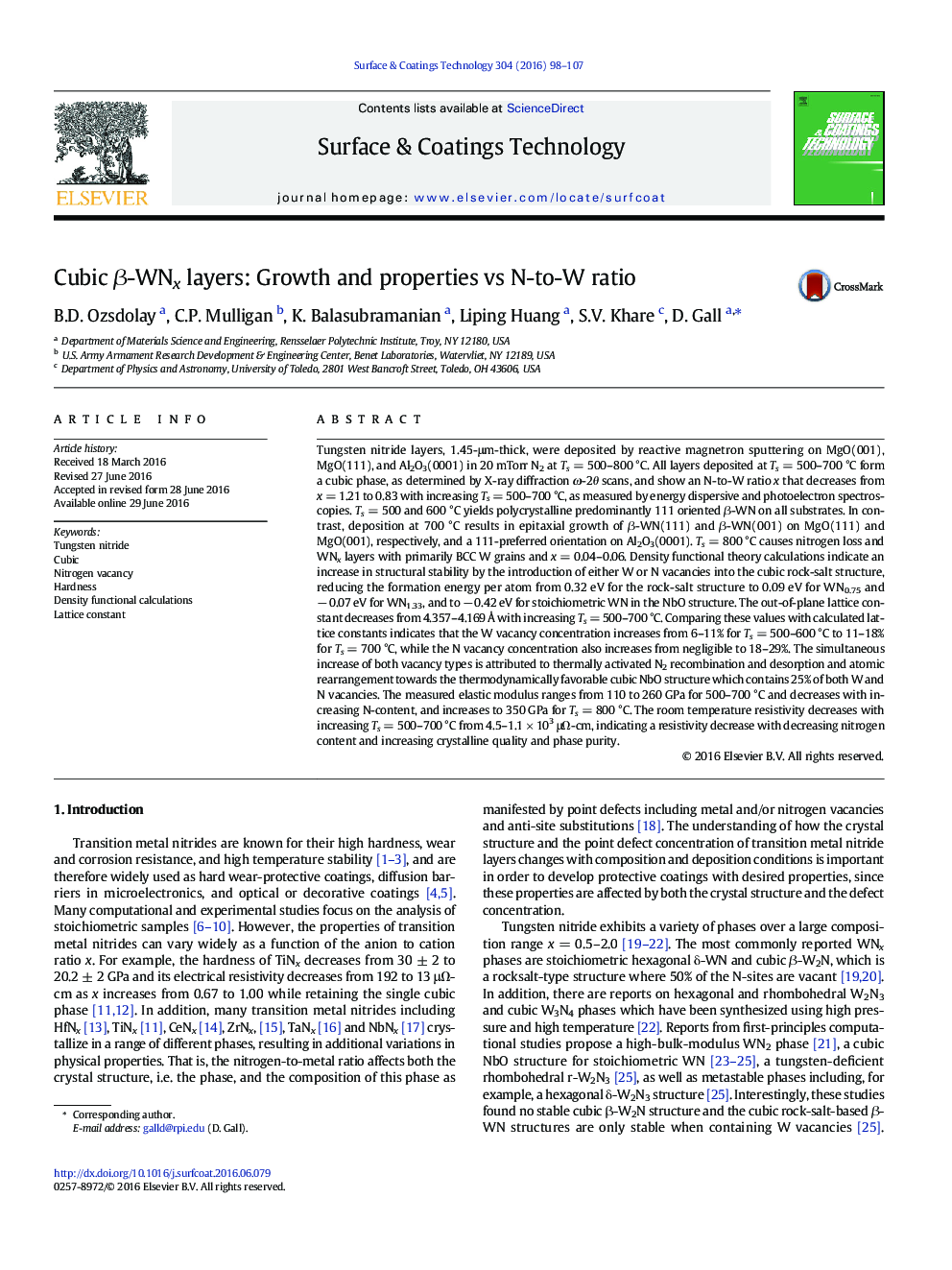| کد مقاله | کد نشریه | سال انتشار | مقاله انگلیسی | نسخه تمام متن |
|---|---|---|---|---|
| 8024859 | 1517576 | 2016 | 10 صفحه PDF | دانلود رایگان |
عنوان انگلیسی مقاله ISI
Cubic β-WNx layers: Growth and properties vs N-to-W ratio
دانلود مقاله + سفارش ترجمه
دانلود مقاله ISI انگلیسی
رایگان برای ایرانیان
کلمات کلیدی
موضوعات مرتبط
مهندسی و علوم پایه
مهندسی مواد
فناوری نانو (نانو تکنولوژی)
پیش نمایش صفحه اول مقاله

چکیده انگلیسی
Tungsten nitride layers, 1.45-μm-thick, were deposited by reactive magnetron sputtering on MgO(001), MgO(111), and Al2O3(0001) in 20 mTorr N2 at Ts = 500-800 °C. All layers deposited at Ts = 500-700 °C form a cubic phase, as determined by X-ray diffraction Ï-2θ scans, and show an N-to-W ratio x that decreases from x = 1.21 to 0.83 with increasing Ts = 500-700 °C, as measured by energy dispersive and photoelectron spectroscopies. Ts = 500 and 600 °C yields polycrystalline predominantly 111 oriented β-WN on all substrates. In contrast, deposition at 700 °C results in epitaxial growth of β-WN(111) and β-WN(001) on MgO(111) and MgO(001), respectively, and a 111-preferred orientation on Al2O3(0001). Ts = 800 °C causes nitrogen loss and WNx layers with primarily BCC W grains and x = 0.04-0.06. Density functional theory calculations indicate an increase in structural stability by the introduction of either W or N vacancies into the cubic rock-salt structure, reducing the formation energy per atom from 0.32 eV for the rock-salt structure to 0.09 eV for WN0.75 and â 0.07 eV for WN1.33, and to â 0.42 eV for stoichiometric WN in the NbO structure. The out-of-plane lattice constant decreases from 4.357-4.169 Ã
with increasing Ts = 500-700 °C. Comparing these values with calculated lattice constants indicates that the W vacancy concentration increases from 6-11% for Ts = 500-600 °C to 11-18% for Ts = 700 °C, while the N vacancy concentration also increases from negligible to 18-29%. The simultaneous increase of both vacancy types is attributed to thermally activated N2 recombination and desorption and atomic rearrangement towards the thermodynamically favorable cubic NbO structure which contains 25% of both W and N vacancies. The measured elastic modulus ranges from 110 to 260 GPa for 500-700 °C and decreases with increasing N-content, and increases to 350 GPa for Ts = 800 °C. The room temperature resistivity decreases with increasing Ts = 500-700 °C from 4.5-1.1 Ã 103 μΩ-cm, indicating a resistivity decrease with decreasing nitrogen content and increasing crystalline quality and phase purity.
ناشر
Database: Elsevier - ScienceDirect (ساینس دایرکت)
Journal: Surface and Coatings Technology - Volume 304, 25 October 2016, Pages 98-107
Journal: Surface and Coatings Technology - Volume 304, 25 October 2016, Pages 98-107
نویسندگان
B.D. Ozsdolay, C.P. Mulligan, K. Balasubramanian, Liping Huang, S.V. Khare, D. Gall,